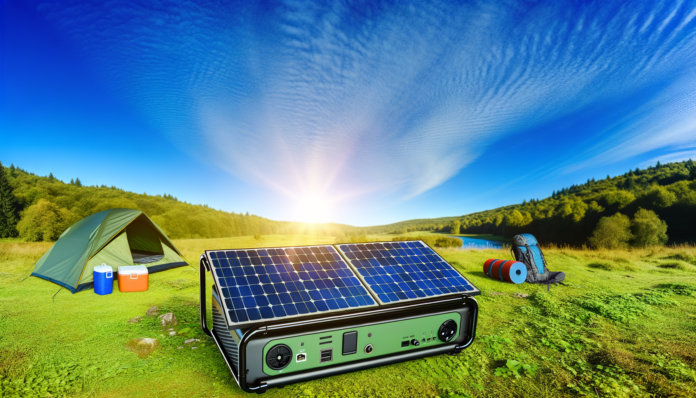Introduction to Portable Solar Generators
What Are Portable Solar Generators?
Portable solar generators are compact, mobile power systems that harness energy from the sun to generate electricity. They typically consist of solar panels, a battery for energy storage, a charge controller to manage the flow of electricity, and an inverter to convert the stored energy into a usable form. Unlike traditional generators that rely on fossil fuels, portable solar generators use clean, renewable energy, making them an eco-friendly alternative. These generators can come as all-in-one kits or as separate components that you can assemble based on your needs.
Why Consider a Portable Solar Generator?
There are several compelling reasons to consider a portable solar generator:
- Eco-Friendly: Portable solar generators use renewable energy, reducing your carbon footprint and contributing to a cleaner environment.
- Cost-Effective: While the initial investment may be higher, there are no ongoing fuel costs, making them cheaper in the long run.
- Quiet Operation: Unlike traditional generators, solar generators operate quietly, making them ideal for camping and other outdoor activities.
- Low Maintenance: With fewer moving parts and no need for fuel, portable solar generators require minimal maintenance.
- Versatility: These generators can be used in various settings, from camping trips to emergency backup power at home.
Who Can Benefit from Using One?
Portable solar generators are versatile and can benefit a wide range of users:
- Campers and Outdoor Enthusiasts: For those who love spending time in nature, a portable solar generator provides a reliable power source for charging devices, running small appliances, and lighting.
- RV and Van Life: People living in RVs or vans can use portable solar generators to power their essential appliances, reducing their reliance on traditional power sources.
- Homeowners: In areas prone to power outages, a portable solar generator can serve as a backup power source, ensuring that essential devices and appliances remain operational.
- Remote Workers: For those who work in remote locations without reliable access to electricity, a portable solar generator can power laptops, tools, and other professional equipment.
- Emergency Preparedness: Having a portable solar generator on hand can be a lifesaver during natural disasters or other emergencies, providing power for critical devices like medical equipment and communication tools.
In summary, portable solar generators offer a sustainable, cost-effective, and versatile solution for various power needs, making them an excellent choice for anyone looking to harness the power of the sun.
Key Features to Look For
When selecting a portable solar generator, it’s essential to consider several key features to ensure it meets your specific needs. Below are the primary aspects to evaluate:
Power Output and Capacity
The power output and capacity of a solar generator are crucial factors. **Power output** is measured in watts (W) and determines the types of devices you can power. For instance, a generator with a 2000W output can handle more demanding appliances like refrigerators or power tools, while a 600W model might be sufficient for smaller devices like laptops and smartphones.
**Capacity**, measured in watt-hours (Wh), indicates how much energy the generator can store. A higher capacity means you can run your devices for longer periods. For example, a generator with a 1500Wh capacity can power a 100W device for 15 hours (1500Wh/100W = 15 hours). It’s essential to match the generator’s capacity with your energy consumption needs to avoid running out of power unexpectedly.
Battery Type and Storage
Portable solar generators typically use either **Lithium Nickel Manganese Cobalt Oxide (NMC)** or **Lithium Iron Phosphate (LFP)** batteries. Each type has its pros and cons:
– **NMC Batteries**: These are lighter and more compact, making them ideal for portability. However, they have shorter life cycles and slightly lower safety ratings.
– **LFP Batteries**: These are heavier and larger but offer longer life cycles and higher safety. They are more suitable for users who prioritize durability and longevity over portability.
Understanding the battery type helps you choose a generator that aligns with your priorities, whether it’s portability or long-term reliability.
Portability and Weight
The portability of a solar generator is a significant consideration, especially if you plan to use it for outdoor activities like camping or road trips. **Weight** and **size** are directly influenced by the generator’s capacity and battery type. Smaller models (e.g., 500Wh) are easier to carry but offer less power, while larger models (e.g., 2000Wh) provide more power but are bulkier and heavier. Assess your portability needs to find a balance between power and convenience.
Durability and Build Quality
Durability is vital for a portable solar generator, particularly if it will be used in rugged environments. Look for generators with **robust build quality**, including features like water-resistant casings and reinforced corners. High-quality materials and construction ensure the generator can withstand harsh conditions and last longer, providing better value for your investment.
Additional Features
Modern portable solar generators come with various additional features that enhance their functionality and convenience:
– **USB Ports**: Essential for charging small devices like smartphones and tablets.
– **AC Outlets**: Necessary for powering larger appliances and electronics.
– **DC Outlets**: Useful for devices that require direct current.
– **Wireless Charging**: Some models offer wireless charging pads for added convenience.
– **Multiple Charging Options**: Generators that support solar, wall, and car charging provide flexibility in different scenarios.
– **Display Screens**: Informative displays that show battery status, input/output power, and other metrics can be very helpful.
These features can significantly impact the usability of the generator, so consider which ones are most important for your needs.
By carefully evaluating these key features, you can choose a portable solar generator that best suits your power requirements, usage scenarios, and personal preferences.
Assessing Your Power Needs
Calculating Your Energy Consumption
Before selecting a portable solar generator, it’s crucial to understand your energy consumption. This involves identifying all the devices you plan to power and their respective energy requirements. Each device’s power consumption is typically measured in watts (W) and can usually be found on the device itself or in its user manual.
To calculate your total energy consumption, follow these steps:
1. **List all devices**: Write down every device you intend to power with the generator.
2. **Note the wattage**: Record the wattage of each device.
3. **Estimate usage time**: Determine how many hours per day you will use each device.
4. **Calculate daily consumption**: Multiply the wattage by the number of hours for each device to get the daily watt-hour (Wh) consumption.
For example, if you plan to use a 60W laptop for 5 hours and a 10W LED light for 10 hours, your daily energy consumption would be:
– Laptop: 60W * 5 hours = 300Wh
– LED light: 10W * 10 hours = 100Wh
– **Total daily consumption**: 300Wh + 100Wh = 400Wh
Matching Generator Capacity to Your Needs
Once you have calculated your daily energy consumption, the next step is to match this with a generator that has the appropriate capacity. Portable solar generators are rated in watt-hours (Wh), which indicates how much energy they can store.
When choosing a generator, consider the following:
– **Battery capacity**: Ensure the generator’s battery capacity meets or exceeds your daily energy consumption. For instance, if your daily consumption is 400Wh, a generator with a 500Wh capacity would be suitable, providing a buffer for unexpected needs.
– **Recharge time**: Check how long it takes to recharge the generator. This is particularly important if you rely on solar panels, as weather conditions can affect charging efficiency. A generator that charges quickly can be more reliable during extended use.
– **Continuous and surge power**: Some devices require a higher initial power surge to start. Ensure the generator can handle both the continuous power needs and the surge power requirements of your devices.
Considering Future Power Requirements
It’s wise to think ahead and consider any potential future power needs. Your energy consumption may increase over time, especially if you plan to add more devices or if your usage patterns change.
Here are some tips for future-proofing your investment:
– **Choose a generator with expandable capacity**: Some models allow you to add extra batteries or solar panels, increasing the overall capacity and flexibility.
– **Opt for higher capacity**: If your budget allows, select a generator with a higher capacity than your current needs. This provides a cushion for future increases in energy consumption.
– **Monitor and adjust**: Regularly review your energy usage and adjust your setup as needed. This might involve adding more solar panels or upgrading to a larger generator.
By carefully assessing your power needs, you can select a portable solar generator that not only meets your current requirements but also adapts to future demands, ensuring a reliable and sustainable power source.
Types of Portable Solar Generators
When choosing a portable solar generator, it’s essential to understand the different types available to match your specific needs. Portable solar generators come in various sizes and capacities, each suited for different applications. Here, we break down the three main categories: small, lightweight models; mid-range models; and high-capacity models.
Small, Lightweight Models
Small, lightweight solar generators are perfect for those who need a portable power solution for minimal energy requirements. These models are typically compact and easy to carry, making them ideal for activities like camping, hiking, or short road trips.
**Key Features:**
– **Portability:** These models are designed to be easily transportable, often weighing less than 10 pounds.
– **Power Output:** They usually offer a power output ranging from 100 to 300 watts, sufficient for charging small devices like smartphones, tablets, and cameras.
– **Battery Capacity:** The battery capacity is generally between 150 to 300 watt-hours, providing enough power for a few hours of use.
– **Recharge Time:** Due to their smaller capacity, these generators can often be recharged relatively quickly, sometimes within 2-3 hours using solar panels.
**Examples:**
– **Bluetti EB3A:** Known for its fast charging time and clear display, it can recharge in just 81 minutes from a wall outlet.
– **Jackery Solar Generator 240:** Offers a compact design and sufficient power for basic needs, making it a popular choice for outdoor enthusiasts.
Mid-Range Models
Mid-range solar generators strike a balance between portability and power capacity. These models are suitable for more extended outdoor activities, small home offices, or as a backup during short power outages.
**Key Features:**
– **Portability:** While still portable, these models are heavier, typically weighing between 20 to 30 pounds.
– **Power Output:** They offer a power output ranging from 300 to 800 watts, capable of running small appliances like mini-fridges, fans, and laptops.
– **Battery Capacity:** The battery capacity ranges from 500 to 1000 watt-hours, providing more extended usage times.
– **Recharge Time:** These generators can take 4-6 hours to recharge fully using solar panels, depending on the model and solar input capacity.
**Examples:**
– **EcoFlow Delta Mini:** With an 882-watt-hour battery, it can power small appliances and charges quickly, making it a versatile mid-range option.
– **Oupes 600W Solar Generator Kit:** Offers a good balance of capacity and cost, with a 595-watt-hour battery and a 100-watt solar panel.
High-Capacity Models
High-capacity solar generators are designed for those who need substantial power for extended periods. These models are ideal for home backup systems, RVs, or off-grid living.
**Key Features:**
– **Portability:** These models are the least portable, often weighing over 50 pounds, but they usually come with wheels or handles for easier movement.
– **Power Output:** They offer a power output ranging from 1000 to 3000 watts, capable of running larger appliances like refrigerators, microwaves, and even power tools.
– **Battery Capacity:** The battery capacity ranges from 1000 to 3000 watt-hours, providing enough power for several days of use.
– **Recharge Time:** Due to their larger capacity, these generators can take 8-12 hours to recharge fully using solar panels, but some models support faster charging with multiple panels.
**Examples:**
– **Jackery Solar Generator 2000 Pro:** Known for its fast charging time and high capacity, it can charge fully in just 2.5 hours with six solar panels.
– **Bluetti AC200P:** Offers a massive 2000-watt-hour capacity and can handle high surge outputs, making it suitable for heavy-duty applications.
Understanding these categories will help you choose the right portable solar generator that fits your specific needs, whether it’s for a weekend camping trip or as a reliable backup power source for your home.
Practical Tips for Using Portable Solar Generators
Optimal Placement for Solar Panels
To maximize the efficiency of your portable solar generator, proper placement of the solar panels is crucial. **Direct sunlight** is essential for optimal charging. Here are some tips to ensure you get the most out of your solar panels:
- Angle and Orientation: Position the panels at an angle that captures the most sunlight throughout the day. In the Northern Hemisphere, this generally means facing the panels south.
- Avoid Shading: Ensure that the panels are not shaded by trees, buildings, or other obstructions. Even partial shading can significantly reduce the efficiency of the panels.
- Mobility: If possible, move the panels throughout the day to follow the sun’s path. Some advanced models come with solar tracking systems that automatically adjust the panel’s position.
- Weather Considerations: Be mindful of weather conditions. Cloudy days will reduce the charging efficiency, so plan accordingly if you rely on solar power for extended periods.
Maintaining and Storing Your Generator
Proper maintenance and storage of your portable solar generator can extend its lifespan and ensure it operates efficiently when you need it most. Here are some key points to consider:
- Regular Cleaning: Keep the solar panels clean by wiping them down with a damp cloth to remove dust and debris. Dirty panels can reduce the amount of sunlight they capture.
- Battery Care: Follow the manufacturer’s guidelines for battery maintenance. This may include periodic full discharges and recharges to maintain battery health.
- Storage Conditions: Store the generator in a cool, dry place when not in use. Extreme temperatures can affect battery performance and longevity.
- Check Connections: Regularly inspect all cables and connections for wear and tear. Replace any damaged components to ensure efficient power transfer.
Safety Considerations
Safety should always be a priority when using portable solar generators. Here are some important safety tips to keep in mind:
- Avoid Overloading: Do not exceed the generator’s power capacity. Overloading can damage the generator and connected devices.
- Proper Ventilation: Ensure the generator is placed in a well-ventilated area to prevent overheating. Avoid using it in enclosed spaces.
- Water Resistance: While some models are water-resistant, it’s best to keep the generator and solar panels dry. Avoid using them in heavy rain or wet conditions.
- Emergency Preparedness: Keep a fire extinguisher nearby and know how to use it. In case of any electrical issues, disconnect the generator immediately.
- Follow Manufacturer’s Instructions: Always read and follow the manufacturer’s guidelines and safety instructions. This ensures you use the generator correctly and safely.
By following these practical tips, you can ensure that your portable solar generator operates efficiently and safely, providing reliable power whenever and wherever you need it.
Environmental and Economic Benefits
Reducing Your Carbon Footprint
Portable solar generators offer a significant advantage in reducing your carbon footprint. Unlike traditional gas-powered generators, which emit harmful pollutants such as carbon monoxide and nitrogen oxides, solar generators produce clean, renewable energy. By harnessing the power of the sun, these devices eliminate the need for fossil fuels, thereby reducing greenhouse gas emissions and contributing to a healthier environment.
- No Emissions: Solar generators operate without emitting any pollutants, making them an eco-friendly alternative to gas-powered generators.
- Renewable Energy Source: Solar energy is abundant and renewable, ensuring a sustainable power supply without depleting natural resources.
- Reduced Air Pollution: By using solar generators, you help decrease air pollution, which is beneficial for both human health and the environment.
Long-Term Cost Savings
While the initial investment in a portable solar generator may be higher than that of a traditional gas-powered generator, the long-term cost savings are substantial. Solar generators have minimal operating costs since they do not require fuel. Additionally, they have fewer moving parts, which translates to lower maintenance costs over their lifespan.
- Fuel Savings: Solar generators eliminate the need for purchasing fuel, which can be a significant ongoing expense with gas-powered generators.
- Low Maintenance: With fewer mechanical components, solar generators require less maintenance, reducing the overall cost of ownership.
- Longevity: High-quality solar generators can last for many years, providing a reliable power source and further enhancing cost savings over time.
Supporting Sustainable Living
Investing in a portable solar generator is a step towards a more sustainable lifestyle. These devices not only provide a clean energy solution but also promote energy independence and resilience. Whether you are using a solar generator for camping, emergency backup, or off-grid living, you are contributing to a more sustainable future.
- Energy Independence: Solar generators allow you to generate your own power, reducing reliance on the grid and enhancing energy security.
- Resilience: In the event of power outages or natural disasters, solar generators provide a reliable source of electricity, ensuring that essential devices and appliances remain operational.
- Promoting Green Technology: By choosing solar generators, you support the development and adoption of green technologies, encouraging further innovation and investment in renewable energy solutions.
In summary, portable solar generators offer numerous environmental and economic benefits. They help reduce your carbon footprint, provide long-term cost savings, and support a sustainable lifestyle. By investing in a solar generator, you are making a positive impact on the environment and contributing to a cleaner, greener future.
Conclusion
Summarizing Key Points
Portable solar generators offer a versatile and eco-friendly solution for various power needs, from camping trips to emergency backup during power outages. They harness the sun’s energy through solar panels, store it in batteries, and convert it to usable electricity via inverters. Key features to consider when choosing a portable solar generator include power output and capacity, battery type and storage, portability, durability, and additional features like USB ports and AC outlets. Assessing your power needs is crucial, as it helps you match the generator’s capacity to your requirements and consider future power demands. There are different types of portable solar generators, ranging from small, lightweight models to high-capacity units, each suited for different use cases. Practical tips for using these generators include optimal placement of solar panels, proper maintenance, and safety considerations. Lastly, portable solar generators offer significant environmental and economic benefits, such as reducing your carbon footprint and providing long-term cost savings.
Making an Informed Decision
Choosing the right portable solar generator involves a careful evaluation of your specific needs and preferences. Start by calculating your energy consumption to determine the required power output and battery capacity. Consider the generator’s weight and portability if you plan to use it for outdoor activities. Durability and build quality are essential for ensuring the generator can withstand various environmental conditions. Additional features like multiple charging options, built-in inverters, and expandability options can enhance the generator’s functionality and convenience. Comparing prices and features, along with checking the warranty and customer support, will help you make a well-informed decision. By taking these factors into account, you can select a portable solar generator that meets your needs and provides reliable, clean energy.
Future Trends in Portable Solar Technology
The future of portable solar technology looks promising, with ongoing advancements aimed at improving efficiency, capacity, and user experience. Innovations in battery technology, such as the development of more efficient and longer-lasting lithium-ion and solid-state batteries, will enhance the storage capacity and lifespan of portable solar generators. Solar panels are also becoming more efficient and lightweight, making them easier to transport and set up. Integration with smart technology, such as mobile apps for monitoring and controlling the generator, will provide users with greater convenience and control. Additionally, the growing emphasis on sustainability and renewable energy sources will drive further adoption of portable solar generators, making them an increasingly popular choice for both outdoor enthusiasts and those seeking reliable backup power solutions. As these technologies continue to evolve, portable solar generators will become even more efficient, user-friendly, and accessible, solidifying their role as a key component of sustainable living.






